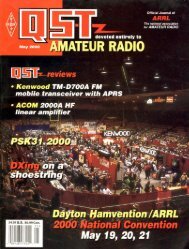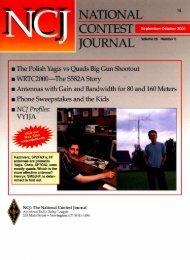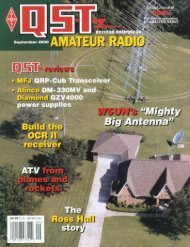By Stephen Stuntz, N0BFImagine riding abicycle built for twothrough thepicturesque countryvistas of France andHolland. Add a fewquaint sidewalk cafesand unending historicaland artistic relevanceand you have the trip ofa lifetime…almost.What’s missing? A onepoundQRP ministation, of course!Cross-Country QRPCMC bikers at a cafe in Provence.“PA/N0BF DE ZS3JDR 599 CFM”zipped through my headphones at 35 wordsper minute. I had broken through the pileupto South Africa with 1 W and a wire danglingfrom my apartment window inRotterdam. A warm glow of accomplishmentspread from head to toe. The decisionto take a compact QRP station along on mybicycle vacation through France and Hollandhad been the right one.When my girlfriend, Jeannie, and I beganplanning the one-month vacation(riding our tandem cycle through parts ofsouthern France and Holland), I decided topack a ham rig that was small, lightweightand easy to set up and operate. The NN1G30-meter QRP CW transceiver I’d built fouryears ago for my first trip to Holland woulddo nicely.The NN1G circuit board was mountedinside a 2×3.5×6-inch plastic box with batteryholders and a touch key. To operate thekey I held the rig in my left hand (makingsure my fingers touched the bottom metalplate) and tapped a bolt on the plastic boxwith my right index finger!The only external devices required foroperation are headphones and a 30-meterdipole antenna. The antenna was made from24-gauge wire and was fed with 10 feet ofRG-174 mini coax to minimize weight andbulk. The antenna was stored on a nylonspool by wrapping the antenna around theoutside and tucking the coax inside the hole.The entire station, minus batteries, weighedonly a pound (AA batteries are readilyavailable in Europe).28 <strong>March</strong> <strong>2000</strong>Planning and PreparationI was preparing to apply for a temporarylicense, previously a bureaucraticnightmare, when the CEPT announcementappeared in <strong>QST</strong>. The article described howthe reciprocal licensing agreement betweenthe United States and many foreign countries,including France and Holland, hadeliminated the need for a temporary license.The ARRL Web site explained how to operatein CEPT countries. I simply packedmy ham license, a copy of “Amateur ServiceOperation in CEPT Countries,” and apassport.Our plan was to spend the first twoweeks participating in an organized tripbeginning in France and ending in Holland.Thirty-two other riders would participatein the ride, which was sponsored by theColorado Mountain Club (CMC). Jeannieand I would stay in Rotterdam for an additionaltwo weeks after the other club membersreturned home.A Week in ProvenceTraveling through “Van Gogh” countryin Provence was inspirational as we rodethrough the fields of flowers that Vincentpainted more than 100 years ago. Ridingfrom Tarascon, we stopped for coffee inSaint Remy, where Vincent painted “StarryNight,” his most famous painting. We pedaledon to Arles, where we spent two nightsand visited the Café La Nuit that Vincenthad captured on canvas. I recognized it immediatelyfrom his impressionist painting.Our days were filled with 35-mile bikerides and historical exploration. Eveningsincluded dining together, drinking wine,telling stories and singing songs until wecouldn’t keep our eyes open. Operating hamradio in the midst of all the activities hadto be quick and easy.I found some time to operate the NN1Gin Uzes before going to bed. I installed nineAA batteries I’d purchased in the smalltown for 15 francs (five dollars) and hungthe antenna from our second-story room. Itwas 10 PM, so there wasn’t time to installthe dipole in a conventional manner. Instead,I put the dipole up in about five minutesby tossing the hot dipole leg out thewindow so it hung next to the outside walland draping the grounded leg around theroom (over pictures, mirrors and light fixtures).To my surprise the little rig came tolife with signals from all over Europe—some with exotic call signs!I answered DL8VL’s CQ as F/N0BF.Klaus, in Dresden, answered me with a 549signal report. John, GW0UWM/QRP,called me from Cardiff, Wales, with a solid599 5-W signal from his MFJ rig. He gaveme a 569 with QSB. He signed 72 after afive-minute QSO when the noise got worse.Klaus, DL8MTG, in Lehre, called me witha 529 report. He was looking for DX, so heQSYd after I gave him a 599 report.Bill, G2FDF, gave me a 559 RST after Ianswered his CQ. We chatted for 30 minutes.Bill was running an FT-1000 into adoublet vee from Oswestry, England. “100km west of Birmingham on road A5 and 32
km due south of Chester” was his reply tomy question, “Where’s Oswestry?” He suggestedthat we come to England and spendthe night at his house. He explained howhe frequently came to the US to visit hisdaughter in California. I finally signed withBill at midnight after drowsiness set in. Iwas pleased with my first night on the air.Onward Through HollandAfter a week in France our CMC grouprode the high-speed train to Holland wherewe bicycled through intensely coloredfields of tulips. Van Gogh must have seenthese same fields when he was growing upand learning how to paint. The experiencemade me think of the similarity between theart of communicating with sound (to sendCW messages) and the art of communicatingwith color (to paint pictures).Jeannie and I spent the last two weeksin an apartment in Rotterdam after the otherCMC people returned to Colorado. Again,setting up my mini QRP station took only afew minutes. The antenna configurationwas similar to the one I used in France—but now I was on the 11th floor!During the next three days the antennaworked flawlessly. Karel, OK1CBD, gaveme a 539 report from Beroun, Czech Republic.Dorothy, M0AXC, gave me a 579report from Dorset, England. She askedquestions about our day trips to Gouda,Delft and the North Sea. She signed with a“bon voyage” after a 20-minute QSO witharmchair copy. OH0/OK1XDF/P, on AlandIsland near Finland, and ZS3JDR, fromSouth Africa, gave me 599 signal reports.They were both popular DX stations so Ihad to use considerable patience callingbetween pileups to work them. Jose,EA7AIN, gave me a 559 RST from Malaga,Spain. Jose was my first Saturday morningQSO. All of the previous QSOs had beenin the evening.The little rig’s side tone sounded raspyon Saturday evening and the strength of theincoming signals had dropped, suggestingan antenna problem. The wire hanging overthe handrail was only 10 feet long after Ipulled it up! Someone in an apartment belowhad apparently snipped the wire fromhis balcony.I modified the antenna by using themetal handrail on the balcony as a counterpoiseto replace the cut dipole leg. Theremaining dipole leg was moved from insideof the apartment, connected to the centercoaxial conductor and tossed over thehandrail. The coaxial shield was connecteddirectly to the handrail with an alligatorclip. I minimized the possibility of a secondcutting by casting the antenna wire offthe balcony before each operating sessionand gathering the wire into a coil whenI was finished. The process felt a bitJeannie and me riding tandem in Holland.My sleepy QSO with G2FDF.like fishing for QSOs.My first catch with the “handrail” antennawas Dan, F5IQJ, in southeasternFrance, who gave me a signal report of 549.He didn’t speak English but understood thathe was copying a 1-W signal fromRotterdam. He gave up trying to understandthe details of the bicycle vacation andsigned off with a 72. My second catch wasDX station HG4I in Hungary, who gave mea 599 report. Breaking through the pileupshowed me that the “handrail” was reallygetting out.On May 13, every store in Holland shutdown for “Ascension Day,” celebratingChrist’s final ascent into heaven. I workedtwo stations with special call signs thatcoincided with the celebration. IQ3AC inItaly gave me a 599 RST and asked me toQSL via IK3GES. 9A770N in Croatia gaveme a 599 RST and asked me to QSL via9A1PAB. Both stations were drawing pileups.I’ve sent QSLs to each operator in anattempt to understand the connection toAscension Day and the reason for its popularity.My final contact was with Tom, EI1AJ/QRP, from Dublin, Ireland. He gave me a329 RST and I gave him a 559 RST for his5-W signal. His cheerful “cheerio” was thelast message logged in my journal.Take Your Radio AlongIntegrating QRP into the vacation hadbeen more successful than expected. Mytotal setup and operating time (includingrepairing the cut antenna) had been onlyfour hours. I had worked 14 stations in 12countries from Finland to South Africa aswe bicycled through France and Holland.In addition, two of the stations were QRP.Taking ham radio hadn’t interfered withour trip. In fact, making new friends andlearning about their culture enhanced it. Nexttime you plan a trip outside the country, considerincluding ham radio. Reciprocal licensingand the availability of lightweight QRPequipment make it easy to engineer your own“cross-country QRP” adventure.You can contact the author at 850 Leyden St,Denver, CO 80220; n0bf@juno.com.<strong>March</strong> <strong>2000</strong> 29
- Page 6 and 7: March 2000 Volume 84 Number 3David
- Page 11 and 12: THE AMERICAN RADIORELAY LEAGUE INC
- Page 14: Get to Know Your Section ManagerThe
- Page 18: Senate CommerceChairman andPresiden
- Page 22 and 23: GEORGE DOMINICK, W4UWCLooking for a
- Page 26 and 27: CORRESPONDENCEYour opinions count!
- Page 32 and 33: By David A. Rosenthal, N6TSTDXing W
- Page 34 and 35: It was a ham’s dream, sitting onM
- Page 36 and 37: always start at the beginning of me
- Page 38 and 39: An insideview of theQRSerprototype.
- Page 40 and 41: Kits and BoardsWhile the original T
- Page 42 and 43: TT2 PerformanceKeying quality with
- Page 44 and 45: Figure 1—Schematic of the meter-m
- Page 46 and 47: Figure 1—Schematic of the Simple
- Page 48 and 49: tacts I had while using this transm
- Page 50 and 51: chandisers are free to develop “s
- Page 52 and 53: WORKBENCHPROJECTS AND INFORMATION F
- Page 54 and 55: THE HELP DESKSchematic Symbols52 Ma
- Page 56 and 57: paddle. This can be done with eithe
- Page 58 and 59: creator) was providing free PSK31 s
- Page 60 and 61: By H. Ward Silver, N0AXTest Your Kn
- Page 62 and 63: HINTS & KINKSA SIMPLE ANTENNA FLIPP
- Page 64 and 65: By Dave Patton, NT1N2000 Annual Mee
- Page 66 and 67: The Board welcomed three new Vice D
- Page 68 and 69: Craigie nominated Mr. Butler. Mr. B
- Page 70 and 71: D.C., with the specific responsibil
- Page 72 and 73: Table 1Elecraft K2, serial number 0
- Page 74 and 75: two inductors. Don’t let this hap
- Page 76 and 77: Like most transceivers these days,
- Page 78 and 79:
Table 2Alinco DJ-V5TH, serial numbe
- Page 80 and 81:
FCC NewsENHANCED AMATEUR ENFORCEMEN
- Page 82 and 83:
tem is not legal to use as it’s c
- Page 84 and 85:
chance to do it. It may be several
- Page 86 and 87:
officials and the hundreds of train
- Page 88 and 89:
THE WORLD ABOVE 50 MHZDr. Ernest K.
- Page 90 and 91:
EME AnnalsEME (moonbounce) standing
- Page 92 and 93:
DIGITAL DIMENSIONWinLink 2000: A Wo
- Page 94 and 95:
From the Mailbag…Throughout the y
- Page 96 and 97:
AT THE FOUNDATIONSpringing with New
- Page 98 and 99:
(156.7 Hz), 146.52. Adm: $2. Tables
- Page 100 and 101:
It is with deep regret that we reco
- Page 102 and 103:
CONTEST CORRALFeedbackIn the 1999 A
- Page 104 and 105:
By Dan Henderson, N1NDContest Branc
- Page 106 and 107:
Affiliated Club Competition Results
- Page 108 and 109:
1999 IARU HF WorldChampionship Resu
- Page 110 and 111:
N5XU (+KA5WSS,KM5FA,N3TNN)390,104 8
- Page 112 and 113:
RW4AA 1,299,804 2121 172 ARW3GU 879
- Page 114 and 115:
Revised 1999 June VHF QSO Party Rov
- Page 122:
has been around for some time, is a
- Page 126:
154, WB5ZED 232. Tfc: K5WOD 4, NOKW
- Page 130:
Bethpage, NY. Bob Wexelbaum, W2ILP,
- Page 134:
NEW HAMPSHIRE: SM, Mike Graham, K7C
- Page 138:
136longtime member N6DOC. Installat
- Page 142:
tion of the digital network within
- Page 146:
DEC, EC, ASM, and cabinet member at
- Page 150:
148agencies have had a working rela
- Page 156:
CALL SIGN NAME BADGES. Club logos o
- Page 160:
COMPUTERS - WANTED early Pre-1980 m
- Page 176:
Index of AdvertisersADVERTISING DEP
















